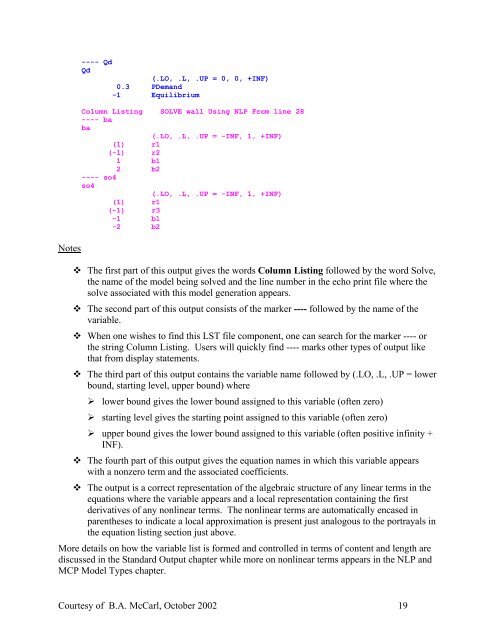You also want an ePaper? Increase the reach of your titles
YUMPU automatically turns print PDFs into web optimized ePapers that Google loves.
Notes<br />
---- Qd<br />
Qd<br />
(.LO, .L, .UP = 0, 0, +INF)<br />
0.3 PDemand<br />
-1 Equilibrium<br />
Column Listing SOLVE wall Using NLP From line 28<br />
---- ba<br />
ba<br />
(.LO, .L, .UP = -INF, 1, +INF)<br />
(1) r1<br />
(-1) r2<br />
1 b1<br />
2 b2<br />
---- so4<br />
so4<br />
(.LO, .L, .UP = -INF, 1, +INF)<br />
(1) r1<br />
(-1) r3<br />
-1 b1<br />
-2 b2<br />
The first part of this output gives the words Column Listing followed by the word Solve,<br />
the name of the model being solved and the line number in the echo print file where the<br />
solve associated with this model generation appears.<br />
The second part of this output consists of the marker ---- followed by the name of the<br />
variable.<br />
When one wishes to find this LST file component, one can search for the marker ---- or<br />
the string Column Listing. Users will quickly find ---- marks other types of output like<br />
that from display statements.<br />
The third part of this output contains the variable name followed by (.LO, .L, .UP = lower<br />
bound, <strong>start</strong>ing level, upper bound) where<br />
lower bound gives the lower bound assigned to this variable (often zero)<br />
<strong>start</strong>ing level gives the <strong>start</strong>ing point assigned to this variable (often zero)<br />
upper bound gives the lower bound assigned to this variable (often positive infinity +<br />
INF).<br />
The fourth part of this output gives the equation names in which this variable appears<br />
with a nonzero term and the associated coefficients.<br />
The output is a correct representation of the algebraic structure of any linear terms in the<br />
equations where the variable appears and a local representation containing the first<br />
derivatives of any nonlinear terms. The nonlinear terms are automatically encased in<br />
parentheses to indicate a local approximation is present just analogous to the portrayals in<br />
the equation listing section just above.<br />
More details on how the variable list is formed and controlled in terms of content and length are<br />
discussed in the Standard Output chapter while more on nonlinear terms appears in the NLP and<br />
MCP Model Types chapter.<br />
Courtesy of B.A. McCarl, October 2002 19
















